There is something magical about bioluminescent insects. About their ability to light up the night as a starry sky. I used to see fireflies everywhere in Thailand, especially during the rainy season. I even spotted some in Central Park in New York. Then I saw some glow worms in Rotorua in New Zealand – a different type of insect, but just as mesmerizing a sight.
But I have never seen any bioluminescent creatures in Australia. Until I discovered some glow worms in the Blue Mountains. I will describe the best sites to see glow worms in the Blue Mountains below.
For the next few months after my discovery, I believed that glow worms were Australia’s (and New Zealand’s) answer to the fireflies of Asia and America. Can you imagine my surprise when I learned that Australia has its own species of fireflies! The trick is, they only shine for a few weeks each year – in December.
So here is my guide to everything you need to know about finding, watching and photographing fireflies and glow worms in Blue Mountains.
READ MORE: How to explore the Blue Mountains by train
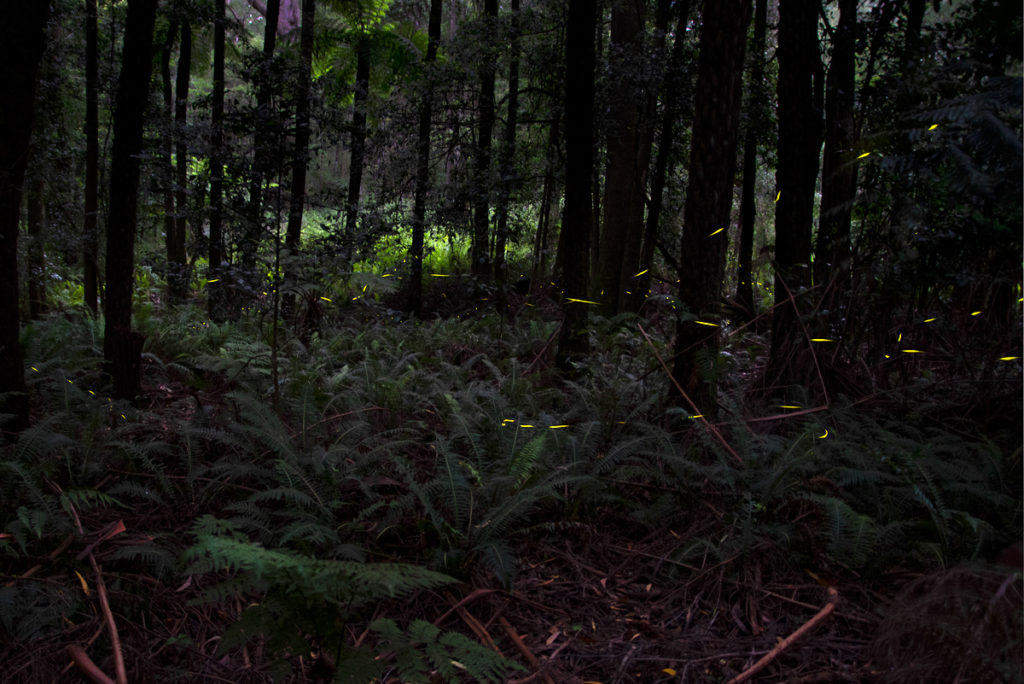
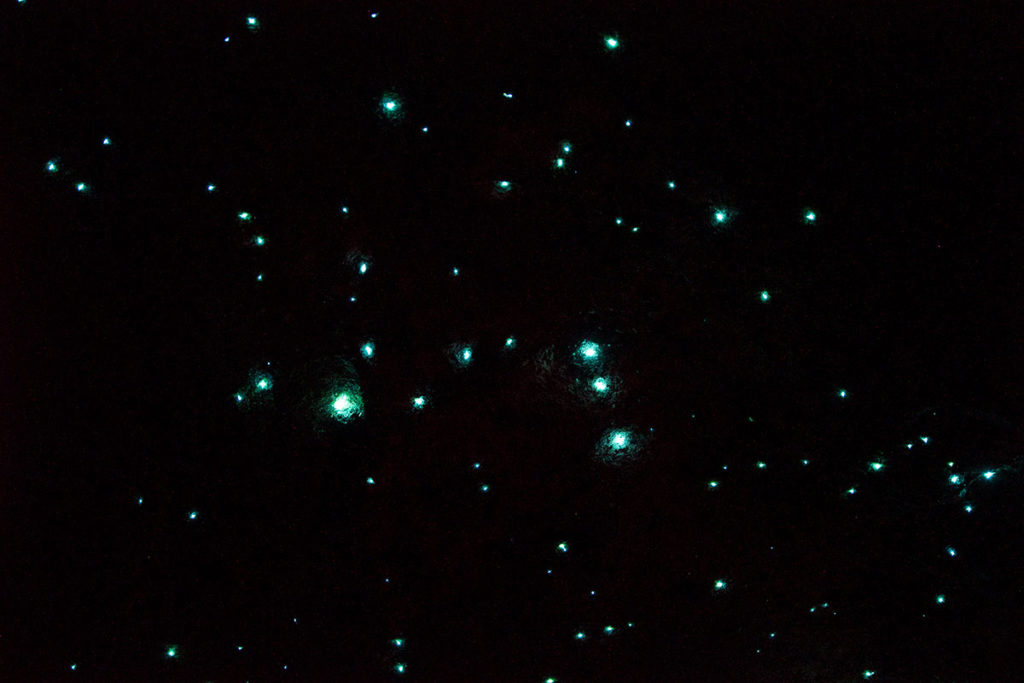
Fireflies in Blue Mountains
What are fireflies
Also known as Lightning bugs, fireflies are neither flies nor bugs. They are nocturnal beetles in the family Lampyridae, closely related to glow worms. In Australia, we have 25 species of fireflies, including the Blue Mountains fireflies (Atyphella lychnus). The adulthood in these species is very short. While their entire life cycle, from egg to reproductive adult, can last up to two years, according to Dr Lesley Ballantyne from Charles Sturt University, the adult stage is very short, probably no longer than a couple of weeks.
During this brief time, their only purpose is to reproduce. They don’t even feed, and some online sources suggest that they don’t have the mouthparts. However, Dr Ballantyne, who has been studying Australian fireflies for 50 years, disagrees. According to Dr Ballantine, “Adult fireflies have well-developed mouthparts and can probably feed but they may not do so and we have no observations to indicate if they feed, nor fresh specimens to dissect to show gut contents. They are probably too busy trying to find the opposite sex”.

In their quest for love, fireflies produce the pulsating light in the segments of their abdomen to find and attract their mates in the dark. Different species produce different sequences of flashes to make sure they attract the ‘right’ mate. In the Blue Mountains, of course, there is only one species of fireflies so there isn’t any confusion about the identity of potential mates.
To produce the light, the abdomens of fireflies contain a chemical called luciferin. And when luciferin is combined with oxygen it produces chemical light. Unlike the light generated in a lightbulb, chemical light is cold and doesn’t take as much energy to produce.
Another interesting thing about fireflies in genus Atyphella to which Blue Mountain firefly belongs is that the females in this genus are flightless. So when you are watching fireflies in the Blue Mountains, you will notice that while some fly through the air, the others are shining from the ground vegetaiton – these are the flightless females.
When can you see fireflies in Blue Mountains
You only have a small window of opportunity to see fireflies in the Blue Mountains. While the precise timing of fireflies emergence is impossible to predict, most of the activity usually falls on mid to late December. Occasionally they can be seen as early as late November, but the best chance would be in the second half of December.
The weather conditions are also important. Fireflies like warm and humid evenings without strong winds. You are unlikely to see them in the rain or in windy nights.
They emerge at dusk – the twilight period before the last rays of sun disappear after sunset. The activity period lasts only about 45 minutes, so it’s best to arrive at the site before sunset, get settled, enjoy the sunset and be ready for the spectacle to begin.
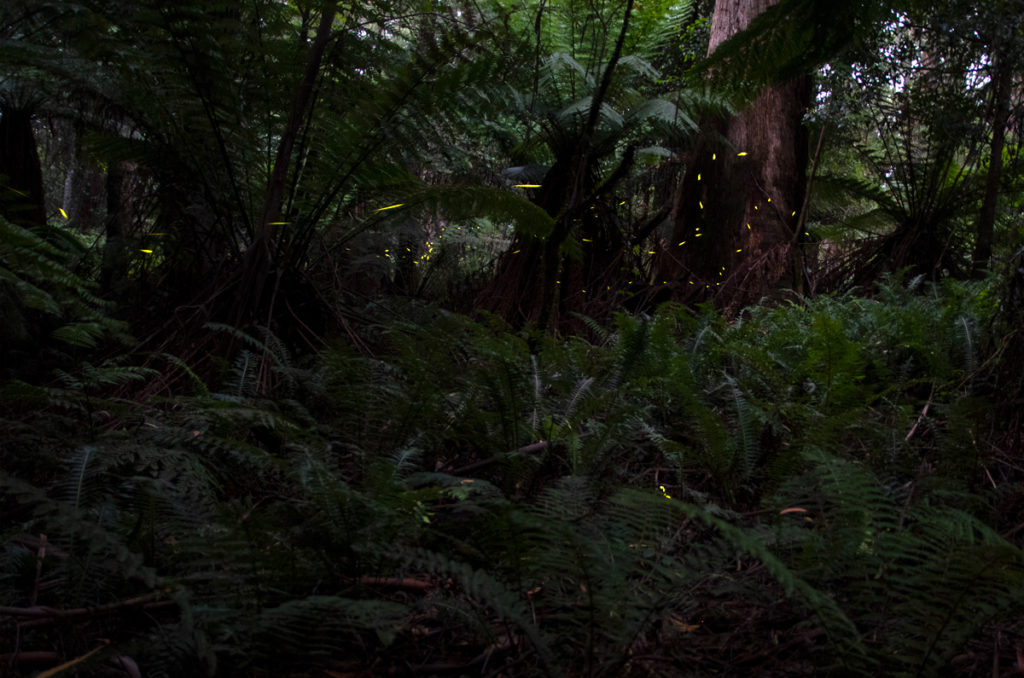
Where can you see fireflies in Blue Mountains
In Australia, fireflies occur in the forests along the coast of New South Wales, Queensland and the Northern Territory.
Cathedral Reserve, Mt Wilson
Fireflies can be spotted in various locations in the Blue Mountains, including Burralow Creek and Glenbrook gullies, but the best place to see them is Mt Wilson, particularly around the creek line in Cathedral Reserve.
If you are planning to photograph fireflies, you need to arrive at the spot well before sunset. You can park at the Cathedral Reserve campground and head for a walk along Mount Irvin Road. There is no way to predict where exactly fireflies will be, but the forest on each side of the road is a good bet. For more details, read this post about watching fireflies at Mt Wilson.
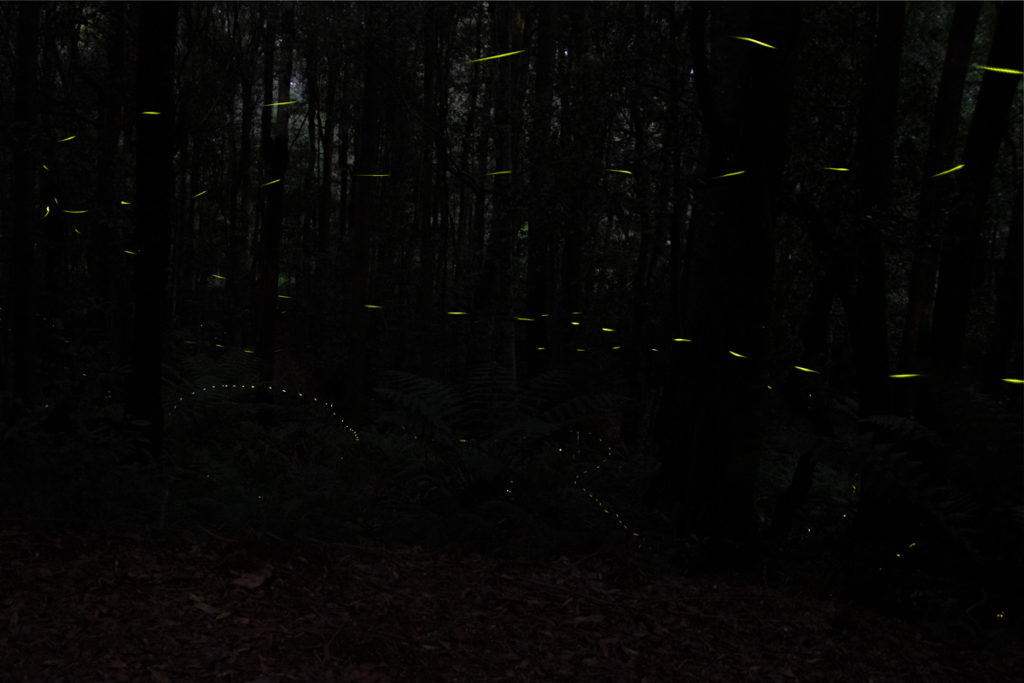
How to photograph fireflies
Photographing fireflies involves a processing technique known as image stacking, where you merge a number of frames into a single image. First, you’ll want to get your base image – a landscape shot against which fireflies will appear later on. So find a scene you like (there are some nice ferns between Cathedral Creek and Mount Irvin Road), set up your tripod and take an image before the light becomes too low. Then set your aperture to 2.8, shutter speed to about 30 seconds (bulb mode) and leave ISO on auto. And then leave your camera and tripod in the same position.
When fireflies emerge and start flying in front of your camera, take as many long exposure images of them as you can. So that when you merge multiple frames into a single later, you will have enough fireflies in your shot.
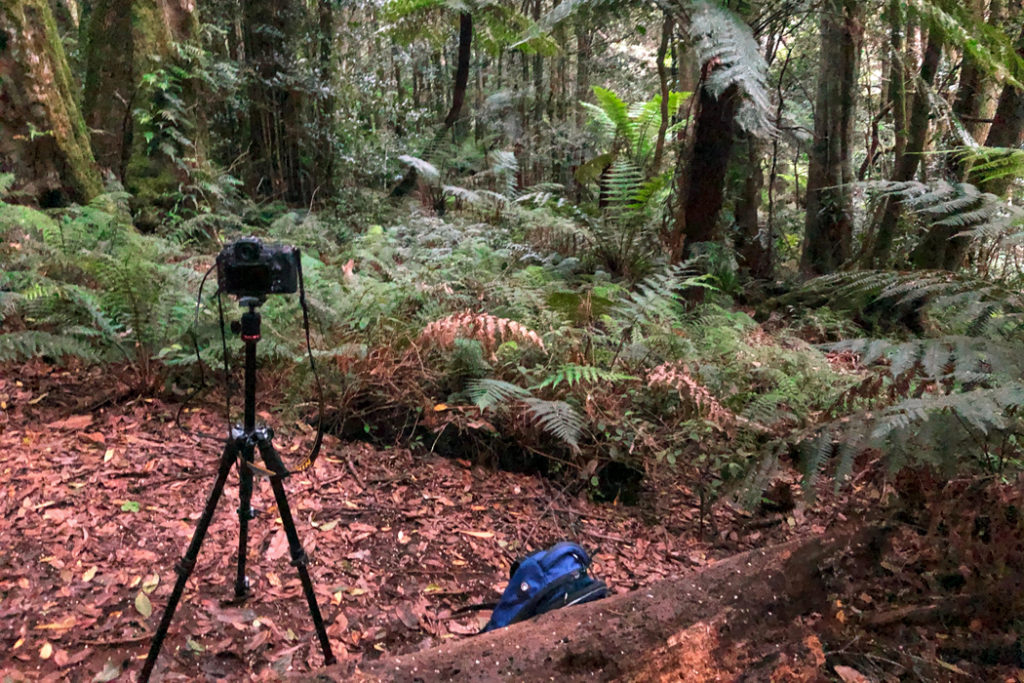
As you can see in the images above, I didn’t have enough patience and moved to a different spot too soon. As a result, I only captured a few fireflies in my images. Resist the temptation to move and over time (fireflies are active for about an hour) you should catch enough activity in front of your camera
When you are ready to process your images, import them into Photoshop as layers. Move your base image to the bottom. Run Auto-align to fix any possible camera movement and then select all layers apart from your base image and change blending mode to Lighten. This will merge your images into a single shot. Merge layers and edit away as you would any other image.
Glow worms in Blue Mountains
What are glow worms
Just like fireflies are not flies, glow worms are not worms. They are the larvae stage of a flying insect – the fungus gnat. And unlike fireflies, glow worms occur only in Australia and New Zealand.
Most glow worm colonies live in caves and tunnels, but some can be found on rock walls next to waterfalls. They generally prefer permanently humid habitats, like rainforests of Gondwana origin and rocky structures.
To trap their insect prey, glow worms make fine spiderweb-like threads, with droplets of sticky liquid and use their bioluminescent bums to attract the insects to them.
So while fireflies glow for love, glow worms glow to kill
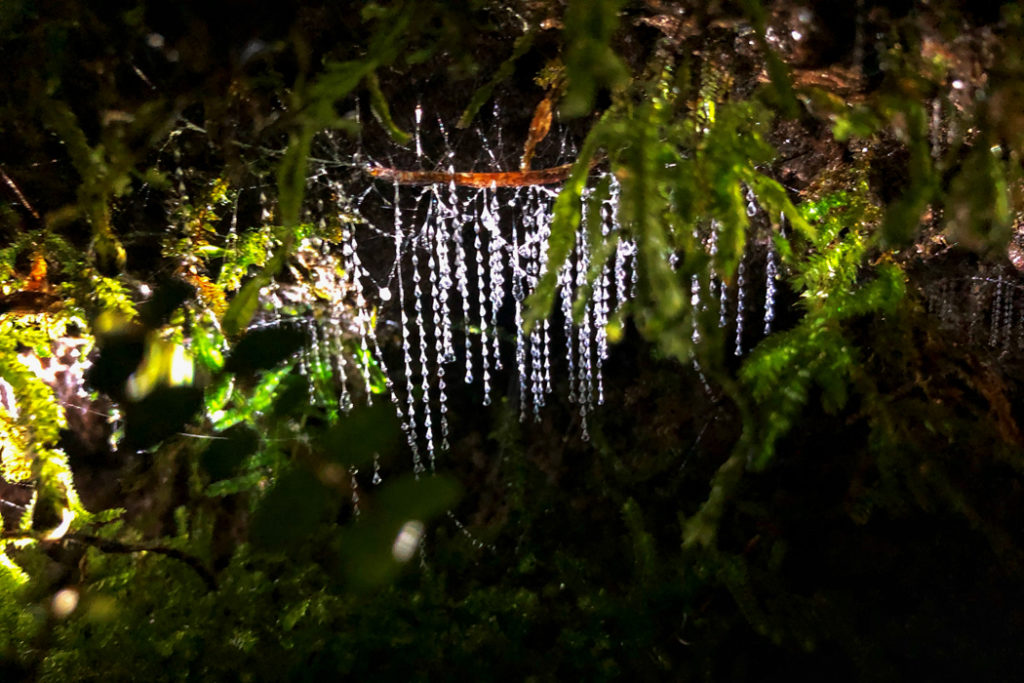
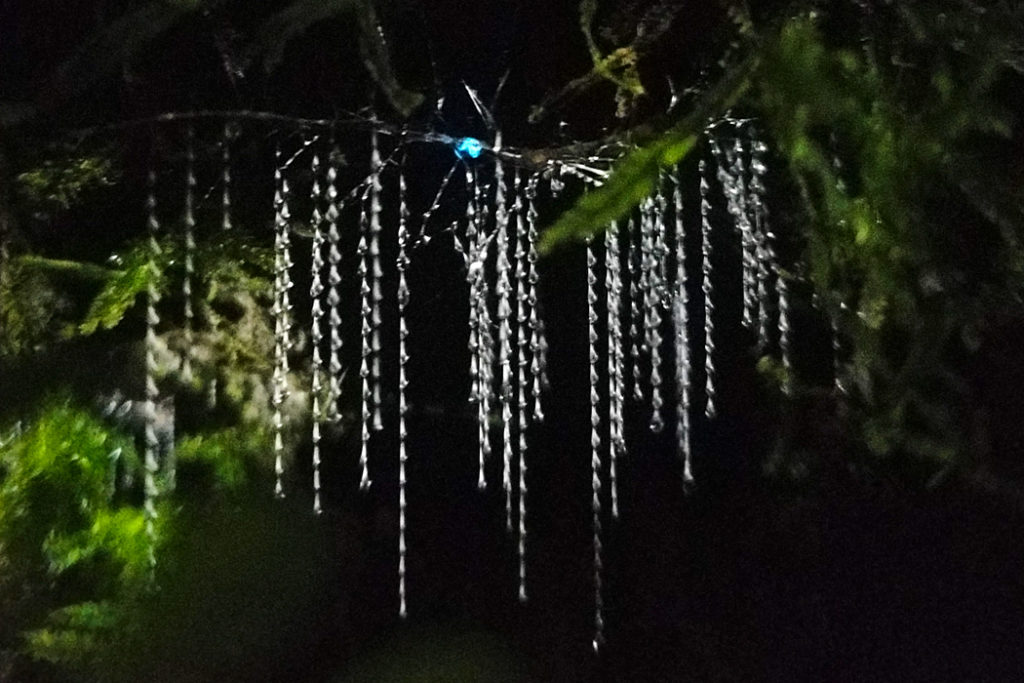
When can you see glow worms in Blue Mountains?
Glow worms can be seen all year round. But the best displays tend to be during the warmer wetter months.
Where can you see glow worms in Blue Mountains?
Many people believe that glow worms live exclusively in caves and therefore assume that a good place to see glow worms is Jenolan Caves. However, while Jenolan Caves are spectacular in their own right, they are not known for glow worms.
Before you head out looking for glow worms in the mountains, please take the time to understand how to minimize the disturbance of your visit to the colony. Glow worms are sensitive to changes in their environment and will often decrease activity when disturbed.
National Parks of NSW suggests the following when visiting glow worms:
- Use your torch to shine on the ground only – do not shine it directly at the glow worms;
- Use red-tinted light around glow worms
- Do not use flash photography (it won’t work) – use a long exposure to capture their light;
- Do not smoke;
- Keep noise to a minimum;
- Do not touch them.
Now that you know how to watch glow worms, here are the best places in the Blue Mountains to see them
Horseshoe Falls, Hazelbrook – Stunning setting
Horseshoe falls are the most assessable and one of the most spectacular glow worm caves in Blue Mountains. There is a large horseshoe-shaped cave behind the waterfall with the trail running through. By day, Horseshoe falls are a picturesque waterfall, and by night it turns into glow worm wonderland.
The glow worm colony occupies the entire cave wall behind the waterfall. They are very easy to see and quite easy to photograph here.
To reach Horseshoe Falls, park at an unmarked car park next to the intersection of Oaklands Road and Hall Parade in Hazelbrook. From the car park, walk along Oaklands road for a few meters past the fenced-off creek and you will reach the signpost at the start of the walk.
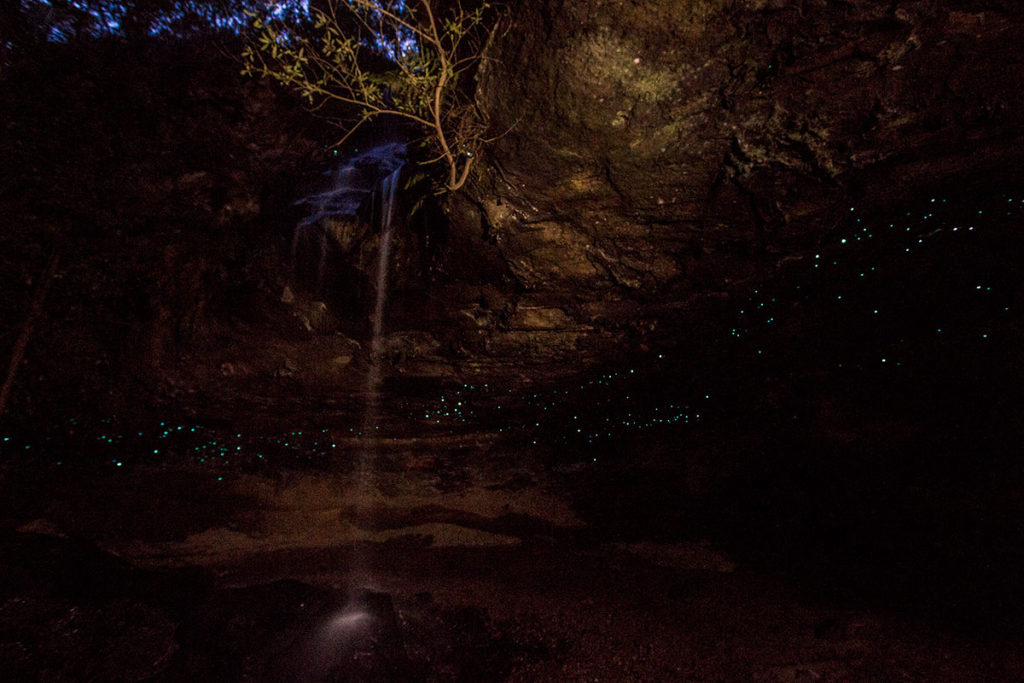
The walk to the falls is about 500 meters. It’s mostly flat, but the section going down to the falls is quite steep. So take your time on the trail. It’s best to walk it while there is still enough daylight and then it’s completely dark on the way back, you’ll know where you are going. Here is my complete guide to visiting Horseshoe Falls and finding glow worms.
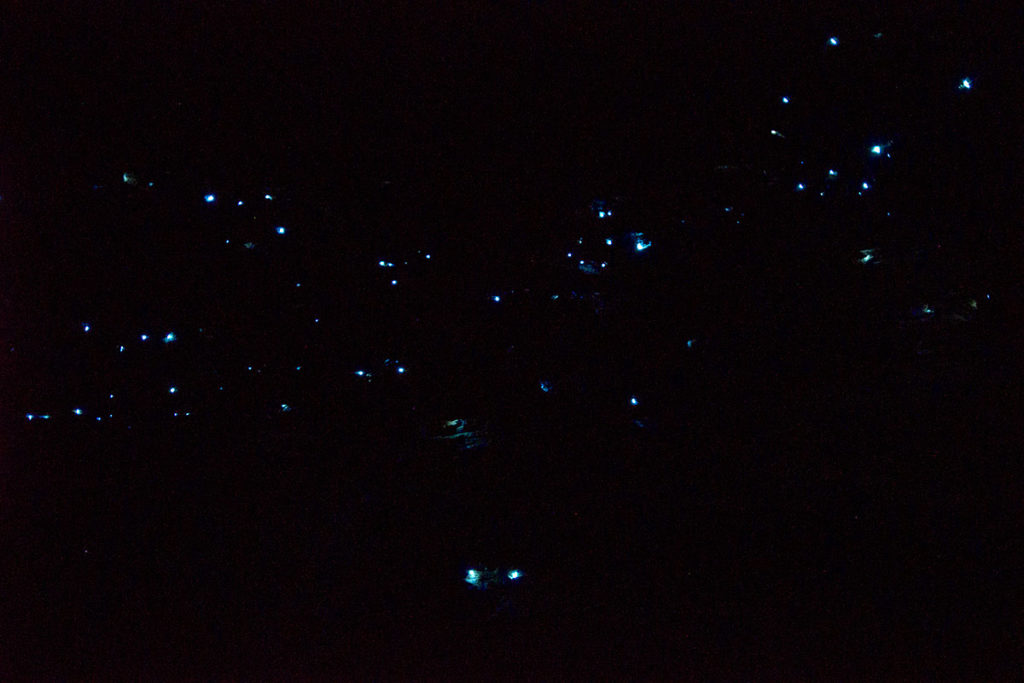
And if you don’t feel like walking in the forest in the dark on your own, you can join a tour run by a local resident via Airbnb experience to see glow worms at Horseshoe Falls.
Lithgow glow worm tunnel – Can visit during the day
Lithgow glow worm tunnel is another easily accessible glow worm tunnel. And unlike all other sites in this guide, it can be visited during the day. It is a much better-known site that gets a lot more tourist traffic and therefore disturbance. People shine their bright torches left, right, and centre in the tunnel.
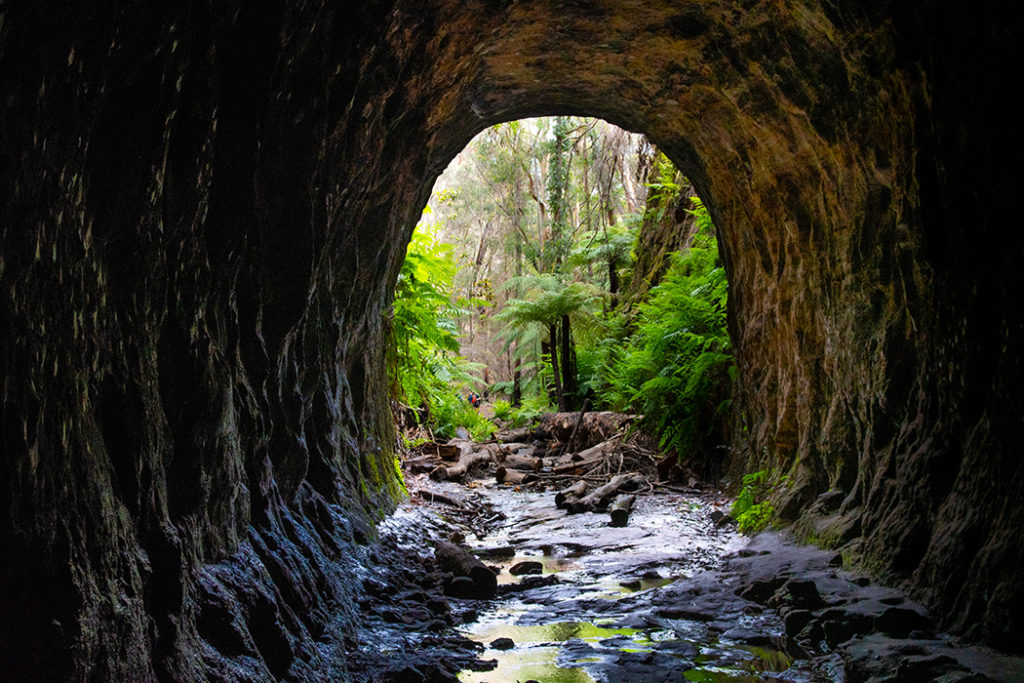
Consequently, glow worm colony in the tunnel is quite thin. The tunnel is a 400-meter long-abandoned railway tunnel that was cut through the mountain to carry shale from the mine to the refinery. There is a bend in the tunnel, about halfway along and this is the best place to see glow worms.
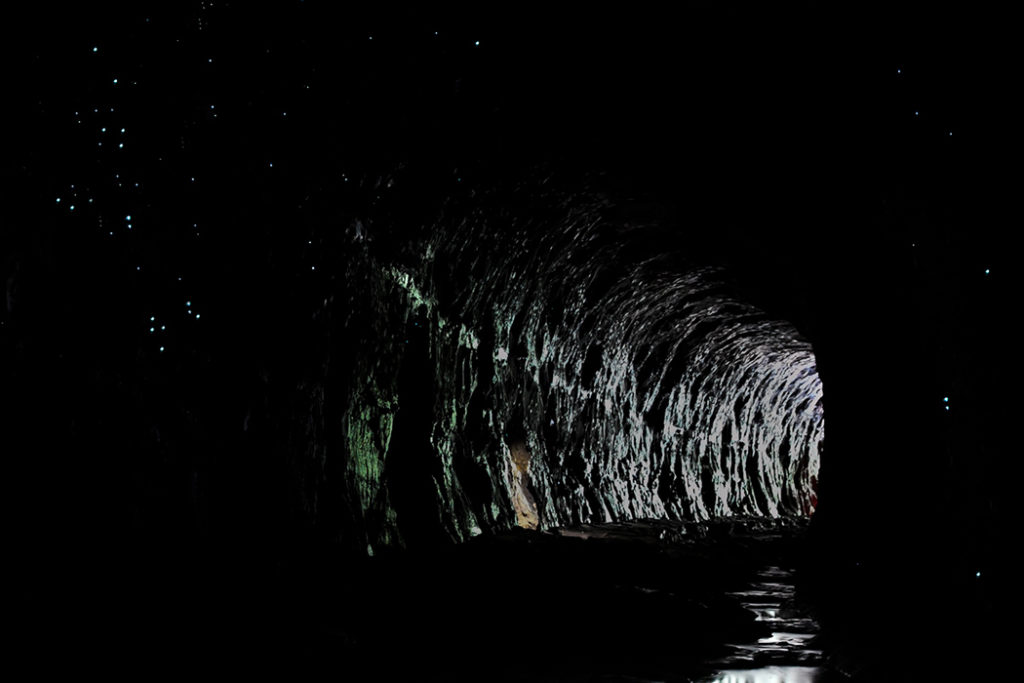
Photography is very challenging in the tunnel because you need at least a minute-long exposure and during this time someone will inevitably come around the corner, their torch blazing.
In terms of access, you can drive up to within 1km of glow worm tunnel along the aptly-named Glow Worm Tunnel Road. Or you could make an adventure out of it and hike in from the stunning Wolgan Valley. There is even a small Canyon to go through on the way. You can book a hike to glow worm tunnel with local guides on Airbnb. Here is my guide to the Glow Worm Tunnel walk.
Burralow Creek – Huge glow worm colony
The most spectacular display of glow worms in Blue Mountains is found at Burralow Creek in lower Grose Valley. It is Australia’s answer to New Zealand’s Waitomo Caves. The rock walls around Bulcamatta Falls are inhabited by thousands upon thousands of glow worms. It’s like standing in the middle of a galaxy surrounded by billions of stars.

The best way to experience this glow worm site is to join this tour with Wildscape Adventures and visit Burralow Creek on a nighttime adventure from Sydney. It’s a fascinating journey into the forest at night down dirt roads and fire trails. Read about our experience on glow worm adventure with Wildscape Adventures.
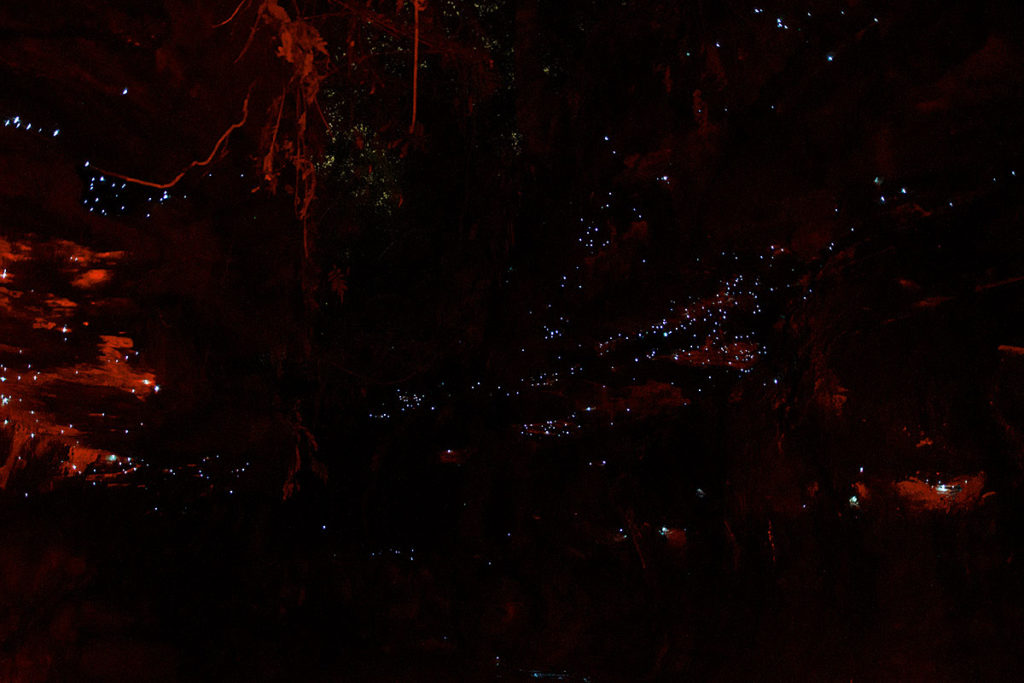
Cataract Falls, Lawson – Waterfall wonderland
This is another waterfall wonderland that transforms into a glow worm show at night. There are five different waterfalls on South Lawson Waterfall Circuit, so it’s a great place to visit in the late afternoon.
The waterfalls loop walk finishes at Cataract Falls and this is where you want to linger until dark. Glow worms live on the rock wall behind the falls, especially to the left of the falls where the wall is covered with ferns.
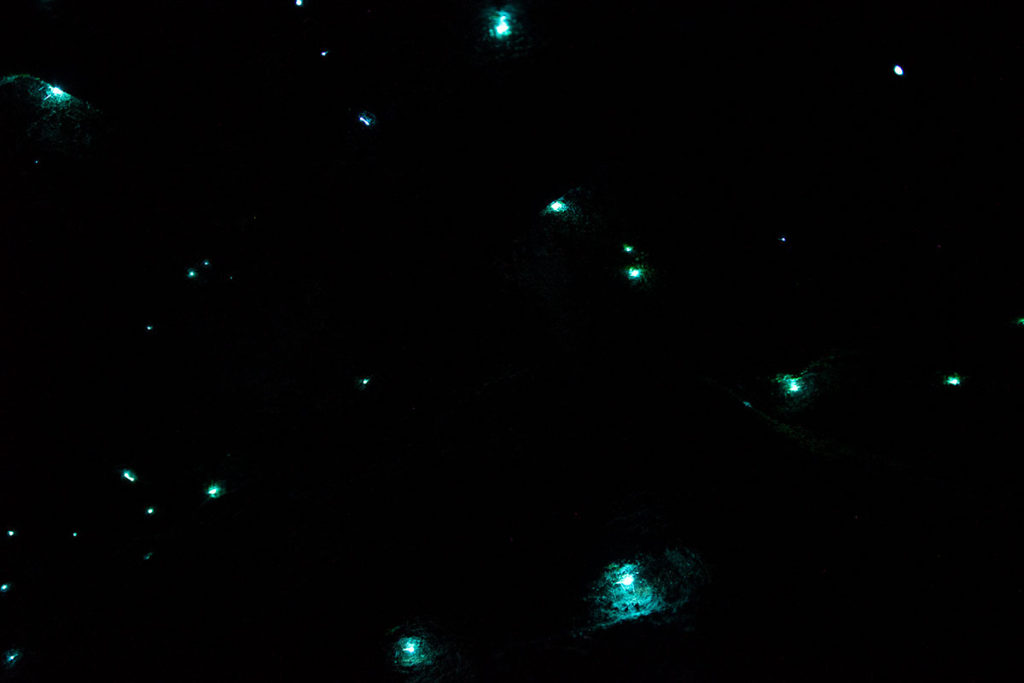
You can get to the cave behind the falls but I wouldn’t risk it at night. It’s not a large cave, like the one at Horseshoe falls, and the way to get inside takes you very close to the ledge. It’s fine in daylight if you are a reasonably flexible person, but at night it would be too easy to misplace your foot and go tumbling down the waterfall.
Most of the glow worms live on the side of the falls anyway, so you can watch them from the sandy ‘beach’ at the base of the falls.
The 350-meter walk back to the car park involves some stairs, but these are well-formed stairs unlike the washed out and slippery steps at Horseshoe falls. Here is my guide to the South Lawson Waterfall walk.
Grand Canyon, Blackheath – For serious adventurers
Grand Canyon is one of the most spectacular hikes in the Blue Mountains (check out my guide to Grand Canyon walk), and it’s even more spectacular at night. The wet rainforest on the bottom of the canyon is home to a large colony of glow worms. It’s one of the most adventurous ways to see glow worms in the Blue Mountains.
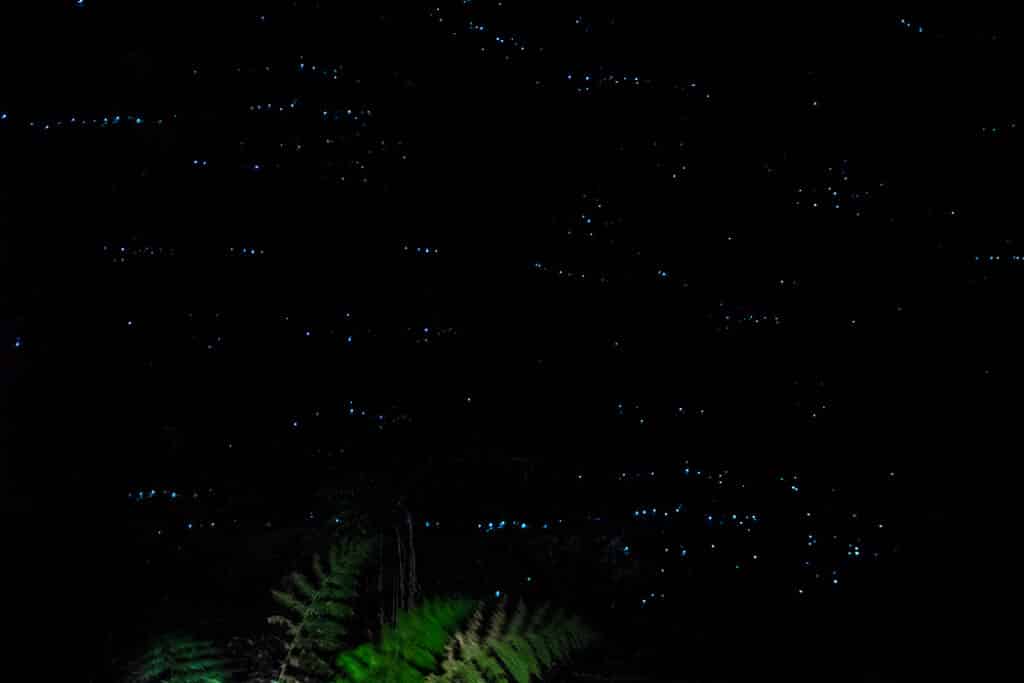
To reach glow worms, start the trail from Evans Lookout. This is a pretty steep descent that takes you all the way down to the canyon’s floor. You start seeing glow worms about 600 meters down the trail and all the way to the Greaves Creek junction at the bottom. The more you descend, the more concentrated the glow worm colonies become.
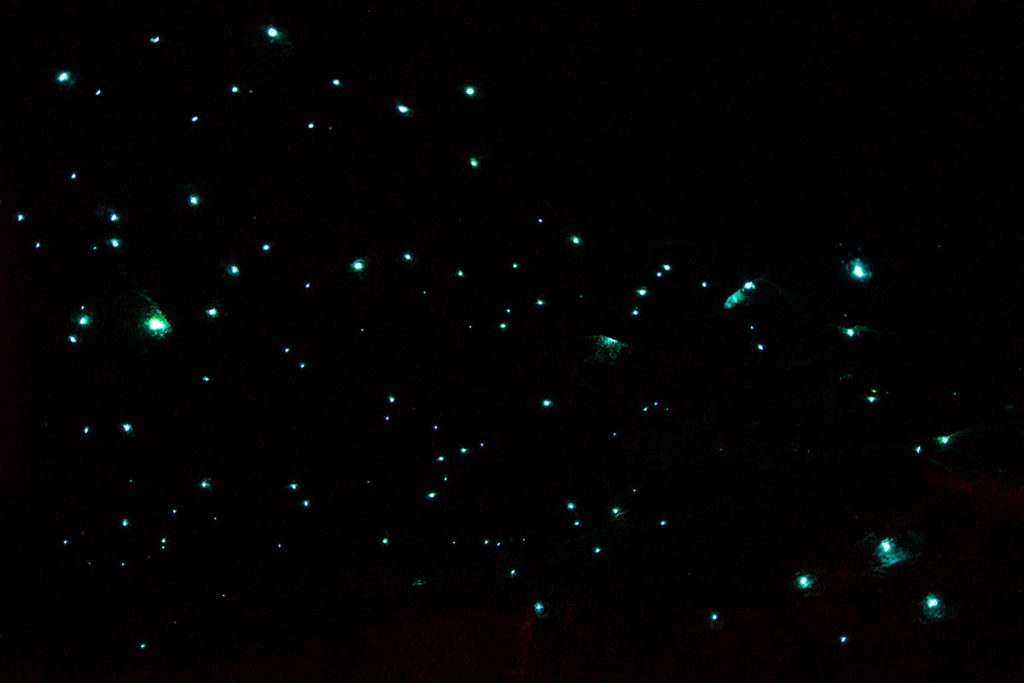
Once you reach the bottom of the canyon, the glow worms will be everywhere although the colonies are not as dense as on the way down.
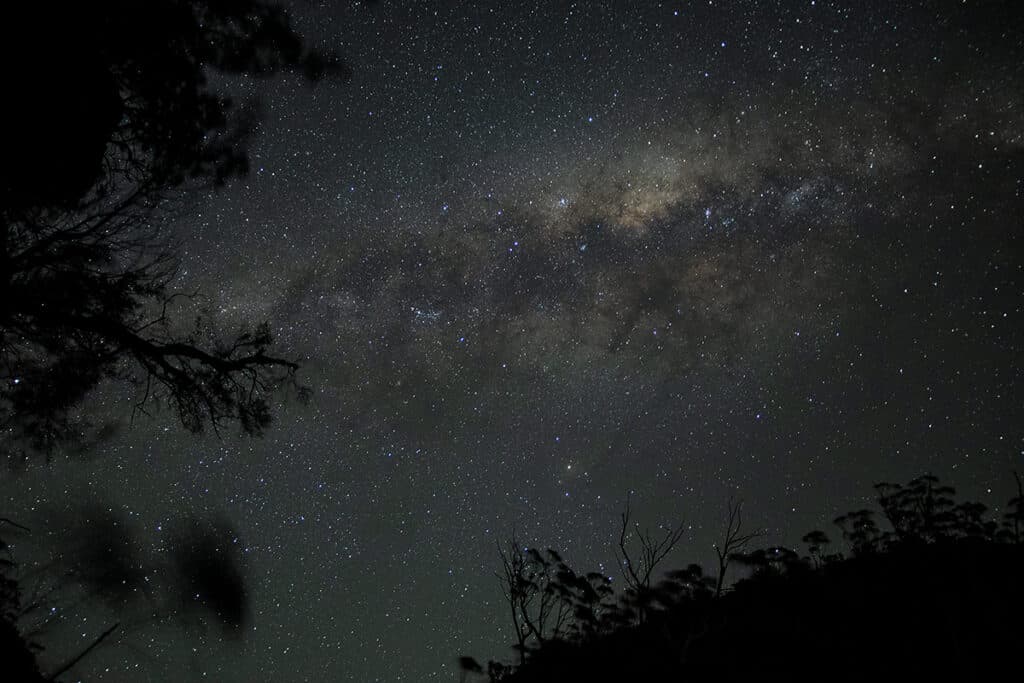
And, of course, don’t forget to look up at the Milky Way above – it is as spectacular as the glow worms.
For the truly adventurous, there is a tour that combines canyoning with glow worm viewing in the Grand Canyon.
Bilpin – When comfort matters
If you prefer organized tours and experiences, you can join a glow worm tour in the Bilpin area, near Mt Tomah Botanic Gardens. This glow worm site is located on private property and can only be visited on a tour.
This experience is all about combining the spectacle with comfort. There is a specially constructed platform in the glow worm canyon where you can sit and watch glow worms at a very close range.
I haven’t done this tour yet, but it is very high on my bucket list.
How to photograph glow worms
Photographing glow worms is as challenging as photographing fireflies, but for different reasons. The biggest challenge with glow worms is focusing on them in total darkness. I use the same technique that works for me for astrophotography. Others may have different tricks.
Here is how I photograph glow worms in total darkness:
- You’ll need a decent DSLR that you can switch to manual mode, a tripod and a wide-angle lens with a wide aperture
- Position your camera (on a sturdy tripod) as close as you can to the worms, without disturbing them
- Set your focus to manual and open your live view (so you can use your LCD screen instead of viewfinder)
- Set your aperture to f2.8 or wider and the glow worms will start appearing on your screen
- Zoom in on a cluster of glow worms.
- Using manual focus ring, focus as well as you can
- Then zoom back out to a wide-angle view
- Set your ISO to 3200 to start with and your shutter speed to 1 minute and start shooting
- From this point, you just keep experimenting with different shutter speeds until you get the best results
Glow worm tours in the Blue Mountains
Here is the summary of glow worm tours available in the Blue Mountains:
- Horseshoe Falls in Hazelbrook with Airbnb Experience
- Burralow Creek with Wildscape Adventures
- Glow Worm Tunnel Hike with Airbnb Experience
- Canyoning and Glow worm viewing in the Grand Canyon
- Bilpin Glow Worm Tour
More things to do in the Blue Mountains
- The Lost World of the Grand Canyon Track in the Blue Mountains
- Blue Mountains by Train: Walks, Views and Waterfalls
- Blue Mountains Jenolan Caves – how to explore the world’s oldest crystal caves
- The Giant Stairway and the Dardenelles Pass – An Epic Walk in the Blue Mountains
- Prince Henry Cliff Walk in the Blue Mountains – Epic Views and Waterfalls
- Echo Point to Scenic World walk in the Blue Mountains
- Best way to visit Wolgan Valley & Lithgow Glow Worm Tunnel
- South Lawson Waterfall Circuit Walk – One Walk, Five Waterfalls
- Finding Fireflies and Glow Worms in the Blue Mountains
- Glow worms and Waterfalls of Horseshoe Falls Walking Track in Hazelbrook

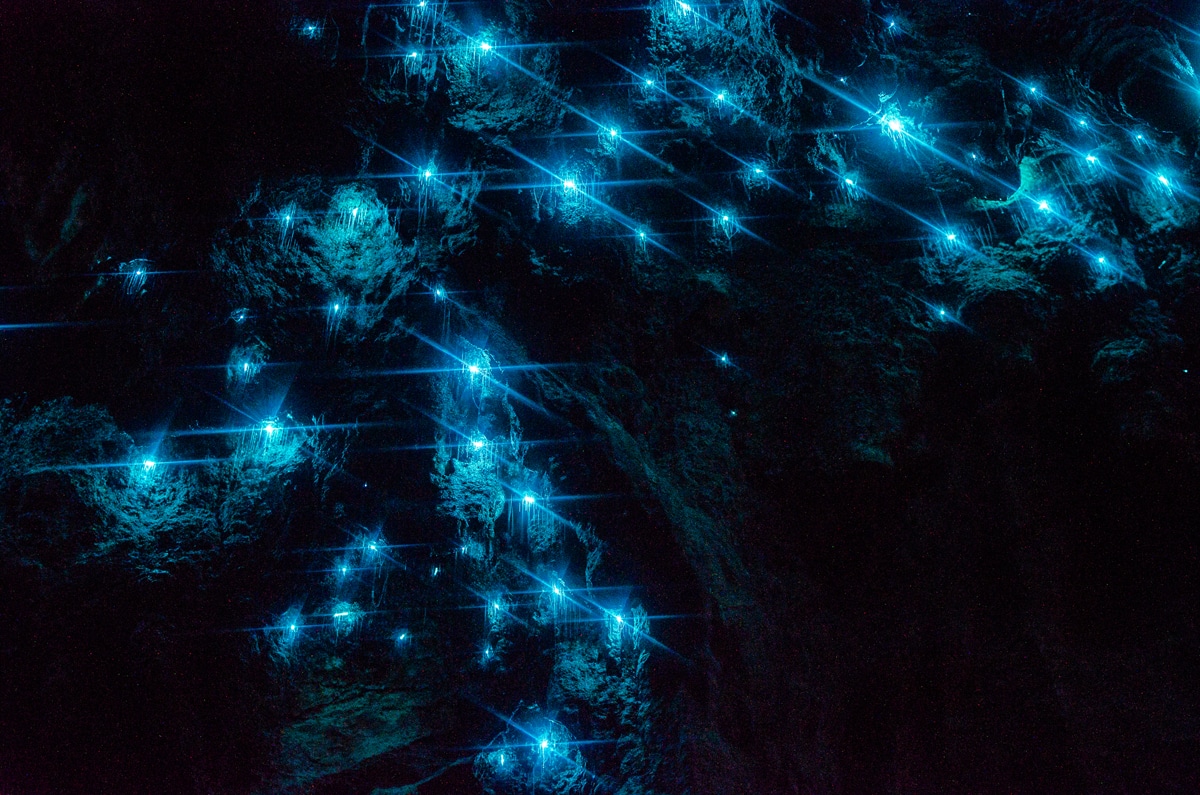
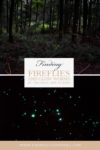
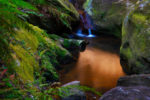
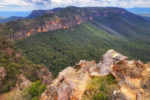
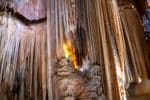
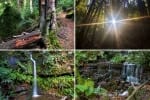
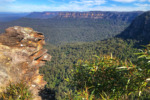
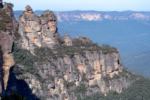
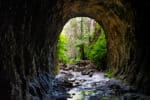
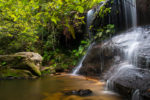

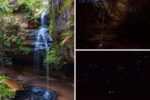
Friends have seen fireflies around Deep Creek, Nambucca Heads NSW and around a bush dam in Grassy Head. I cannot find any references to fireflies on the mid north coast of nsw, but they are here. Do you have any knowledge or info. on fireflies in the mid north coast?
Hi Edmund, I don’t have any insights about firefly sights up the coast. This report popped up today – it mentions Fernmount near Bellingen: https://www.abc.net.au/news/2021-09-10/fireflies-emerge-this-spring-creating-magical-backyard-displays/100439956
Interested to talk to you about firefly biology. Have worked on fireflies including the 25 Australian species for over 50 years. Look forward to hearing from you.
Thank you, Lesley, for taking the time to chat to me about the fireflies.